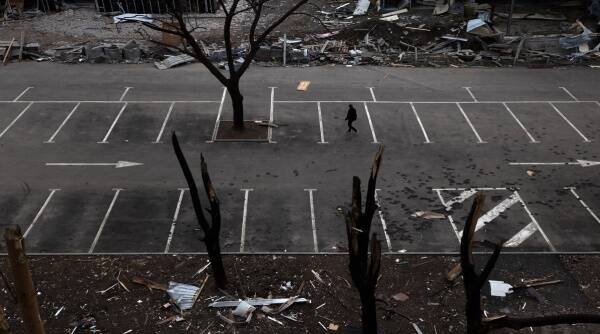Written by Thomas Gibbons-Neff and Natalia Yermak
Two days after more than 50 people were killed on its platforms by a missile strike, the only sounds at the Kramatorsk railway station Sunday morning were a distant air-raid siren and the rhythmic sweeping of broken glass.
“The town is dead now,” said Tetiana, 50, a shopkeeper who was working next to the station when it was attacked as thousands of people tried to board trains to evacuate the eastern city, fearing it would soon be besieged by Russian forces.
https://images.indianexpress.com/2020/08/1×1.png
Friday’s strike was a gruesome turn for the city after nearly eight years of being near the front line of the country’s struggle against Russia-backed separatists in the region known as Donbas.
Check Out Express Premium
Click here for more
The station’s main hall was still filled with streaks of blood and luggage Sunday morning, with the burned-out hulks of two sedans lying in the parking area outside.
Tetiana, who declined to provide her last name, was sure that more death was on the way.
“We are being encircled. We understand that,” added Tetiana, who has lived for 10 years in Kramatorsk, a city with a prewar population of around 150,000 people and that was once one of the industrial hearts of the Donbas. She said she would not leave because she must look after her 82-year-old mother, who is ailing. But she knows more than ever the danger that brings.
“We think we will be swept off the face of the Earth,” she said.
She recalled ducking inside a nearby market Friday to take cover when the missile struck the train station, with what she estimated was 2,000 people inside. A family that took shelter with her at the market was almost crushed by a piece of a falling roof that was sheared off in the blast.

 A damaged apartment building in Kramatorsk, Ukraine, on Sunday, April 10, 2022. (Tyler Hicks/The New York Times)
A damaged apartment building in Kramatorsk, Ukraine, on Sunday, April 10, 2022. (Tyler Hicks/The New York Times)
“There were screams everywhere,” she said. “Nobody could understand anything, cars were burning, and people were running.”
With Moscow’s decision to shift the focus of its war to eastern Ukraine, the people who remain in Kramatorsk fear that they will soon be shelled into oblivion, like the residents of Kharkiv and Mariupol, two other cities that have been ruthlessly assaulted by Russian forces. It feels like an assault here is inevitable: Cutting off Kramatorsk would partly cut off Ukrainian forces fighting in the eastern breakaway regions where Russia is consolidating.
At the city’s main hospital, City Hospital 3, staff members were preparing for the kind of destruction that has swept over other urban centers. Their supplies for mass trauma are ample, one doctor said. But, he added, many of the nurses have evacuated, and there was a shortage of critical care physicians.
In Kramatorsk, residents have started to hunker down, preparing for a siege. Most small shops have been closed; a few grocery stores remain open; and the city square, once teeming with people during these warm spring days, is all but empty.
Just after noon Sunday, Tetiana closed the small candy and coffee confectionery where she worked. It would be shuttered for the foreseeable future, as its main source of income, the train station’s passengers, were gone.
Still, orange-vested maintenance workers tried to clean around the wreckage from the strike: parts of the train station itself, people’s shoes, a bag of potatoes and broken glass. A pack of stray dogs, frequent visitors to the area around the station, limped around the debris. The workers swept where they could until a water truck arrived, hosing down the blood that had pooled by the outside entrance.
In the distance, the thud of artillery reverberated, barely loud enough to hear but still easily felt.
“We’re closing down,” Tetiana said. “There is no point. There are no people.”

 Debris outside the Kramatorsk train station in Kramatorsk, Ukraine, on Sunday, April 10, 2022. More than 50 people were killed on Friday in a strike on the Kramatorsk train station. (Tyler Hicks/The New York Times)
Debris outside the Kramatorsk train station in Kramatorsk, Ukraine, on Sunday, April 10, 2022. More than 50 people were killed on Friday in a strike on the Kramatorsk train station. (Tyler Hicks/The New York Times)
Evacuation vehicles were still leaving the city but not at the volume they had in the days before. One resident said that buses sent from western Ukraine were already leaving unfilled. Those who were staying in Kramatorsk, many of them older residents, were bracing for what may lie ahead: making do without electricity; living in cold, damp basements; cooking by fire; and enduring the terror of incoming artillery fire.
But Sunday, dear friends Lidia, 65, and Valentyna, 72, dressed in nice clothes and decided to leave their lifelong homes together. Both women declined to provide their surnames.
“After what happened at the railway station, we can hear the explosions getting closer and closer,” Lidia said. Through tears, Valentyna added, “I can’t take these sirens anymore.” Their destination, as with millions of other Ukrainians since Russia invaded Feb. 24, was somewhere vaguely west — just anywhere farther away.
“We need to leave because we can’t bear it anymore,” Lidia said.
Air-raid sirens in Kramatorsk are not the haunting, distant chorus you hear in the movies. They are, in most cases, just a loud single horn that seems inescapable, whether indoors or out. And if any kind of strike occurs, the sirens usually come afterward, too late, residents complained.
Kramatorsk and the neighboring, but smaller, city of Sloviansk are likely to be the first two cities that will be attacked by whatever Russian forces are able to reconstitute in the region after their defeat and withdrawal from around Kyiv, the capital. For now, the Russian front line traces like a jaw around the two cities.
Encircling and cutting off Kramatorsk and Sloviansk would allow the Russians to isolate the Ukrainian forces who are holding their old front lines in the two breakaway regions — a maneuver, if successfully carried out, that would mean disaster for the Ukrainian military, as much of their forces are there.
Sgt. Andriy Mykyta, a soldier in Ukraine’s border guard, was in Kramatorsk to try to head off that fate.
“There will be a serious fight,” Mykyta said. “This is a tactic of the Russians: They take cities as hostages.”

 The parking lot of an apartment building in Kramatorsk, Ukraine, is littered with debris from Russian bombings on Sunday, April 10, 2022. (Tyler Hicks/The New York Times)
The parking lot of an apartment building in Kramatorsk, Ukraine, is littered with debris from Russian bombings on Sunday, April 10, 2022. (Tyler Hicks/The New York Times)
On Sunday, as he bought an energy drink and some snacks from one of the remaining open grocery stores in the city, the sergeant looked much like every other uniformed Ukrainian service member: a blue stripe on his arm, weathered boots and a jagged tattoo jutting above his collar.
But he was, in fact, one of the most valuable members of the Ukrainian armed forces, a part of the select group that was quickly trained by NATO forces (a several-day course that was supposed to last at least a month, he said) to use some of the more complicated weapons that were helping push back Russian forces: the Javelin and NLAW anti-tank systems.
But he played down the missile systems’ importance, saying, “These weapons are like a doughnut at the end of the day.” He said that the real fight would come down to whatever side could withstand its enemy’s artillery the longest and who retained the will to fight.
“They have tanks and artillery, but their troops are demoralized,” he said.
Maria Budym, a 69-year-old resident of Kramatorsk, shrugged off the artillery and the evacuations. She was staying. When Russian-backed separatists briefly held Kramatorsk in 2014, they were welcomed to the city by some of the pro-Russian population before being driven off by Ukrainian defenders, she said.
This time, she added, the Russians will have to deal with her.
“Only cowards and people already displaced by the war have fled the city,” she said, standing in a blue fleece pullover in front of her hollowed-out Soviet-style apartment. “Our soldiers will defend this city to their last breath.”
Besides, Budym added, with anger in her eyes: “I have a pipe in my apartment. I’ll use it on whoever comes in that door.”

